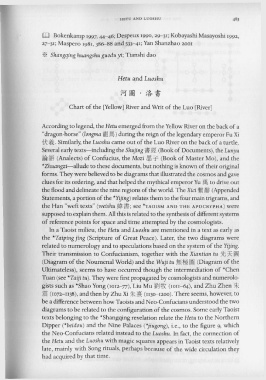Page 523 - The Encyclopedia of Taoism v1_A-L
P. 523
HETU AND L UOS H U
III Bokenkamp 1997, 44- 46; Despeux 1990, 29-31; Kobayashi Masayoshi 1992,
27- 31; Maspero 1981, 386-88 and 533- 41; Yan Shanzhao 200I
* Shangqing huangshu guodu yi; Tianshi dao
Hetu and Luoshu
Chart of the [Yellow] River and Writ of the Luo [River]
According to legend, the Hetu emerged from the Yellow River on the back of a
"dragon-horse" (longma ~F.!§) during the reign of the legendary emperor Fu Xi
fj( ~. Similarly, the Luoshu came out of the Luo River on the back of a turtle.
Several early texts-including the Shujing • ~ (Book of Documents), the Lunyu
~~g (Analects) of Confucius, the Mozi ~.:r (Book of Master Mo), and the
*Zhuangzi-allude to these documents, but nothing is known of their original
forms. They were believed to be diagrams that illustrated the cosmos and gave
clues for its ordering, and that helped the mythical emperor Yu ~ to drive out
the flood and delineate the nine regions of the world. The Xici ~ if (Appended
Statements, a portion of the *Yijing) relates them to the four main trigrams, and
the Han "weft texts" (weishu ~$.; see *TAOISM AND THE APOCRYPHA) were
supposed to explain them. All this is related to the synthesis of different systems
of reference points for space and time attempted by the cosmologists.
In a Taoist milieu, the Hetu and Luoshu are mentioned in a text as early as
the * Taiping jing (Scripture of Great Peace). Later, the two diagrams were
related to numerology and to speculations based on the system of the Yijing.
Their transmission to Confucianism, together with the Xiantian tu )t7( Ii'ED
(Diagram of the Noumenal World) and the Wuji tu $.l€;@1i'ED (Diagram of the
Ultimateless), seems to have occurred though the intermediation of *Chen
Tuan (see *Taiji tu). They were first propagated by cosmologists and numerolo-
gists such as *Shao Yong (IOI2-77), Liu Mu ~u!t\l: (lou-64), and Zhu Zhen 71;:
~ (I072- U38), and then by Zhu Xi 71;: .. (U30- 1200). There seems, however, to
be a difference between how Taoists and eo-Confucians understood the two
diagrams to be related to the configuration of the cosmos. Some early Taoist
texts belonging to the *Shangqing revelation relate the Hetu to the Northern
Dipper (*beidou) and the Nine Palaces (*jiugong), i.e., to the figure 9, which
the Neo-Confucians related instead to the Luoshu. In fact, the connection of
the Hetu and the Luoshu with magic squares appears in Taoist texts relatively
late, mainly with Song rituals, perhaps because of the wide circulation they
had acquired by that time.

